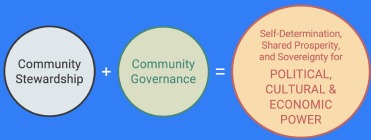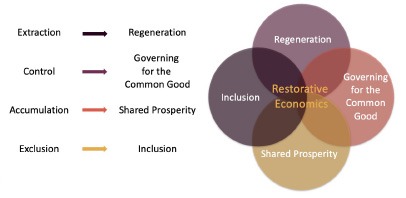
I first read about the Historic Clayborn Temple in history books. The church served as the home base for Memphis sanitation workers organizing and striking against unsafe and inhumane working conditions faced by Black garbage collectors. This strike took place during the height of the Civil Rights Movement in 1968 and produced the powerful “I AM A MAN” images that many of us remember. And it was while supporting those sanitation workers, just a half mile away at the Lorraine Motel on April 4th of that year, that Dr. Martin Luther King Jr. was assassinated.
One of the last trips I took before the pandemic was to visit Anasa Troutman in Memphis to learn more about her restorative development strategy to reclaim the Historic Clayborn Temple as an anchor for a local economy rooted in love, dignity, and collective well-being.
To me, the temple is a humble reminder that the solutions to our most pressing problems are not always shiny and new. The Temple remains standing through years of disrepair, as a symbolic representation of longtime Black residents confronting the push-and-pull of displacement and gentrification. It’s a sacred space for dreaming and building a future world where Black people, and all oppressed people, can come together and heal through building and creating projects and systems that treat all people with care and dignity.
Under Anasa’s visionary leadership, a leadership council of 23 longtime residents from North and South Memphis serve as the governing body for the Temple’s restoration. The council aims to develop the site as a cultural center and economic hub for a local restorative economics strategy rooted in resident-owned housing, cooperative food systems, and worker-owned businesses. Historic Clayborn Temple is a beautiful articulation of what is possible when workers and residents are not limited to fighting for their deserved rights but have the skills and resources to build the communities and livelihoods they want. What is possible is not reduced to what others are willing to give.
Oppressed people around the world have fought for freedom, liberation, and the right to self-determination for hundreds of years. Whether revolting against fascist powers or organizing a protest to win human rights, the compulsion for autonomy and agency over our lives, livelihood, and well-being cannot be denied. We might not be able to describe a place that we have never seen, but we will intuitively know in our body once we have arrived at that place of freedom and joy.
While it is hard to imagine economic models beyond present-day capitalism, it is becoming clearer that our current economic system is deepening the chasm between the haves and have nots at the expense of communities on the frontlines of climate justice, economic disinvestment, and state-sanctioned violence.
Restorative economics invites us to envision what a just economy might look like—to remake society with structures and systems that honor our humanity, invest in our collective healing and well-being, and help us transition towards a model of democratic governance where all communities can live and thrive together.
Restorative Justice and Economics
To end the racial wealth gap and transform our economy, we must first restore and make whole communities that have been harmed and excluded from our current economy. This form of reparations may look like investing in the infrastructure, social programs, and services that make a community strong and vibrant—such as water management systems, public preschool education, or raising the national minimum wage. In other words, restorative economics strategically reinvests resources back into economically oppressed communities so that they can develop the capacity and skills necessary to identify their community economic development priorities.
Achieving those economic objectives also requires engaging in a restorative justice process where we name and acknowledge the economic, and therefore social and political, harm that has been done; understand the root causes of that harm; and identify practices to ensure that those harms are not repeated. Going through a process of accountability, reconciliation, and restitution means:
- Refusing to ignore the harm created by present-day economic policies and practices in Black, Indigenous, and all communities of color
- Centering the needs and interests of those most impacted by an unjust and extractive economy
- As much as possible, restoring those who have been harmed and make them whole, so they can actively participate in creating the next economy.
Why Do We Need Restorative Economics?
In our current market-based, hyper-capitalist system, profit maximization comes first. The consequences are evident: the constant erosion and undermining of rights, protections, and job quality for workers; exploitation of labor from undocumented immigrants and incarcerated people; water and air pollution which exacerbates climate chaos; putting holes in the social safety net; and more. This holy grail of profit by any means necessary ends up amassing and consolidating wealth and power within the hands of a few. And, in the United States, those few hands tend to be white and male.
In 1971, Lewis Powell, later a US Supreme Court justice, addressed a memo to the US Chamber of Commerce. Powell’s memo served as a guide for how corporations should position themselves to take over US democracy. This manifesto, which Greenpeace has labeled a Corporate Blueprint to Dominate Democracy, demonstrates the deliberate and rigorous commitment of corporations to consolidate their power at the expense of vulnerable and oppressed people. Nearly 50 years later, the average CEO earns 264 times more than the average worker’s wage within the same company.
Further compromising democratic control are rampant voter suppression tactics, corporate lobbyists, and laws like Citizens United. Transformation, not reformation, is needed to upend these and many other deeply entrenched injustices.
A Restorative Economics Theory of Change
The methodology of restorative economics leverages community-owned and -governed projects to bring residents together to create shared prosperity, self-determination, and collective power. Restorative economics fosters cultural, economic, and political power for impacted communities through its design, process, and outcomes.

Community Ownership for Shared Prosperity
Cooperative business models and collective ownership are not new ideas. In the South, Ella Josephine Baker helped organize the Young Negro Cooperative League in the 1930s to help Black families leverage their combined resources to boost purchasing power and reduce the cost of goods and services to fellow cooperative members.
Looking back, we can see the creative ways our families and community members supported one another outside of our dominant economic systems. For example, there is the practice of sou-sous, akin to giving circles, in West African traditions, and the Islamic practice of not accepting riba, or charged interest. What may be new is our ability to proliferate and formalize practices of solidarity in the face of global capitalism.
Proposed solutions to addressing structural racism and systemic barriers often focus on identifying social benefits to support disproportionately impacted communities. This may look like creating more entry-level jobs through a workforce development program for residents in underemployed zip codes or creating more green space in urban neighborhoods. While elected officials, corporate contractors, and speculative investors tell impacted communities to be appeased by these benefits, they are earning even more profits, deepening the racial wealth divide—the root cause of the structural barriers that were supposed to be addressed in the first place.
This is not sufficient. Economically oppressed communities need to control capital and exercise agency over their day-to-day lives. Prioritizing investments into projects that are community-owned and stewarded means the project, program, or business is structured so that profits are distributed among all community members. Having an explicit community ownership structure—be it a cooperative, member collective, or multi-member limited liability corporation—helps ensure shared prosperity and builds community wealth, as opposed to benefitting a wealthy individual or corporation.
Governing for the Common Good
What would it look like to have our democratic values shape our economy, instead of having a capitalist economy that shapes our democracy?
Governance is both about how decisions are made—the structures and processes—and who makes the decisions. A focus on the common good invites lawmakers, public administrators, voters, and the public to engage in a process of deep democracy through collaborative governance that fosters transparency, shared understanding, and healing. This includes studying facts and figures, listening to individual experiences, and weighing pros and cons to comprehensively understand a problem and collectively craft a solution before casting a vote.
Governing for the common good emphasizes that when the most vulnerable and impacted community members can live, work, play, and love with dignity, then the rest of society will be able to do so as well. When certain populations are disproportionately impacted by different systems, we must center their voices and interests.
Angela Glover Blackwell, founder of PolicyLink, refers to this as the “curb cut effect.” When disability rights activists won the 1990 Americans with Disability Act, one of the first steps local governments took was to cut the curbs out of sidewalks, making it easier for wheelchair users to use sidewalks. This also made the sidewalk more accessible for people with walkers, pushing strollers, jogging, riding bikes, and more. The law prioritized people with disabilities as the impacted population, and one of the benefits was an improvement in the quality of life for many more people.
Building Power
The transition to a more just and equitable economy involves not only redistributing wealth and changing how decisions are made, but also shifting power. Power is the ability to have choice and exercise agency in making decisions that shape our lives and well-being, and then having access to the resources to implement those decisions. Restorative economics analyzes how power shows up in communities in three different realms that shape one another: culture, economics, and politics.
Cultural Power encompasses the values, norms, and traditions of society. While many subcultures exist, a wealthy elite exercise outsized influence. These values can be seen in today’s economy in the extraction of natural resources from the planet; exploitation of people’s labor, knowledge, and resources; a growing concentration of wealth; exclusion of vast numbers from participation in the economy; and the consolidation of power into the hands of the few. These values manifest in a narrative of bootstrapping, meritocracy, and “entitlement” programs for the poor.
Economic Power builds upon cultural power by using the values and norms of society (extraction, exclusion, exploitation, accumulation, and control) to shape how goods and services are exchanged between people and businesses. For example, national campaigns like OUR Walmart and One Fair Wage have been organizing to raise the minimum wage to a more livable $15 per hour. This economic campaign includes a cultural narrative strategy that challenges the notion that people should get the bare minimum needed to stay alive, insisting instead on the right to live with dignity on a 40-hour workweek. The interplay between cultural and economic power is important because centering new values can reshape how money, services, and products are exchanged.
Political Power speaks to policies and practices that can be upheld in a court of law, through legislation, or judicial precedent. Political power cements the norms and values that govern how goods and services move throughout society and establishes the legal infrastructure to defend their right to do so. This is an ongoing struggle to determine who has which rights to do what with. Ultimately, political power determines what rights we can exercise in society and defend in the court of law.

Conclusion
The framework of restorative economics provides a roadmap—albeit one with forks, detours, twists, and turns—to arrive at a just and equitable economy.
As always, the challenge lies in the implementation. Restorative economics asks us to prioritize five guiding principles: democratic governance, capacity building and human development, non-extractive integrated capital, power building through social movements, and systemic change.
Some of these principles may push funders to lean into unconventional approaches. For example, at the Kataly Foundation where I am CEO and managing director of our Restorative Economies Fund (REF), we are committed to an integrated capital strategy. Recognizing that 501c3 organizations are just one vehicle for change, and strategies like electoral organizing cannot be funded by grant dollars, we deploy different forms of capital to advance real solutions on the ground. This can include loans, loan guarantees, lines of credit, as well as non-financial support such as technical assistance.
The work is complex and unpredictable. We are called to redefine risk, to develop relationships with grantee partners that are deeply rooted in trust and respect, to have challenging conversations with peers, and more.
But these complexities and unpredictable moments make the work beautiful. I dream of the day when I can revisit the Historic Clayborn Temple in Memphis and see Anasa’s vision come to fruition. I do not know exactly what it will look like, but I know what it will feel like: freedom.


0 Commentaires